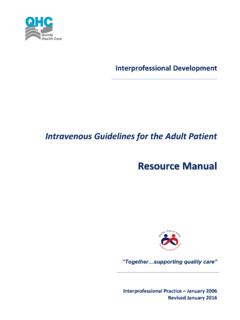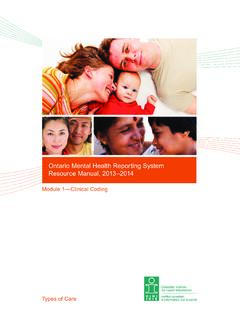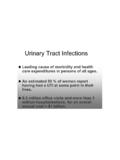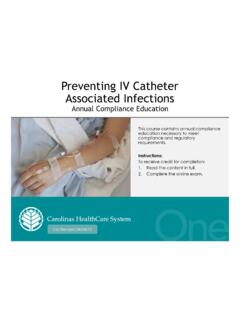Transcription of Peripherally Inserted Central Catheter (PICC)
1 Exceptional care, inspired by you Resource Manual Peripherally Inserted Central Catheters (PICCs). Percutaneous Central Catheters Together supporting quality care . Revised September 2016. TABLE OF CONTENTS. INTRODUCTION .. 3. PICCS .. 4. LOCATION .. 4. TYPES .. 5. INDICATIONS .. 5. CONTRAINDICATIONS .. 6. BENEFITS AND RISKS .. 6. PERCUTANEOUS Central 7. LOCATION .. 7. TYPES .. 7. INDICATIONS .. 8. CONTRAINDICATIONS .. 8. BENEFITS AND RISKS .. 8. NURSING USE AND CARE .. 9. DAILY ASSESSMENTS .. 9. ACCESSING A 9. FLUSHING A CVAD .. 10. DRAWING BLOOD FROM A CVAD .. 10. CHANGING THE DRESSING AND CAP OF A CVAD .. 10. POTENTIAL CVAD COMPLICATIONS .. 11. QUICK 15. REFERENCES .. 16. CVAD QUIZ .. 17. Page 2 of 19 Peripherally Inserted Central Catheters (PICCs).
2 Percutaneous Central Catheters Quality, Patient Safety and Interprofessional Practice INTRODUCTION. This learning package is a resource, designed to standardize education for all nurses caring for patients with Central lines. It is important that the reader know Quinte Healthcare Corporation (QHC) policies on Central Venous Access Devices (CVAD's). and have successfully been certified on the care and maintenance of Central lines before managing Central lines independently. This package is intended to be a part of orientation to CVAD care and maintenance. If at the completion of this program you feel that you are unable to perform these skills, it is your responsibility to confer with your Clinical Educator, Nurse Manager, or Charge Nurse/delegate.
3 Practice Guidelines 1. Nurses will attend in-service training as provided by QHC, which includes theory, anatomy & physiology, demonstration and practice of all CVAD applications currently used in QHC. 2. Nurses will complete a test and achieve a minimum of 80%. 3. Nurses will be supervised at least two times for each skill by a nurse competent in Central line care and maintenance. Evaluating nurses will document on the appropriate Skills Checklist including date and signature. Comments should include whether or not the candidate is safe to practice independently. 4. Completed checklist should be photocopied, with one copy given to the staff member and original to Unit Manager. Continuing Competence It is strongly recommended that certified nurse's review all skills related to the care and maintenance of Central lines on an ongoing basis to ensure continued competence.
4 If at any time the nurse feels additional review/retraining is required, it is the responsibility of that nurse to seek additional education/resources from the manager, or clinical educator/delegate to ensure continued competence related to CVAD care and maintenance. Nurses are professionally responsible for ensuring that they have the requisite knowledge, skill and judgment necessary to provide safe and effective infusion therapy (CNO, 2002). Page 3 of 19 Peripherally Inserted Central Catheters (PICCs). Percutaneous Central Catheters Quality, Patient Safety and Interprofessional Practice Peripherally Inserted Central Catheter (PICC). A Peripherally Inserted Central Catheter (PICC) is a small gauge Catheter that is Inserted Peripherally but the tip sits in the Central venous circulation in the lower 1/3 of the superior vena cava.
5 It is suitable for long term use and there are no restrictions for age, or gender. Location PICCs are commonly placed at or above the antecubital space in the following veins: Cephalic vein: The cephalic vein ascends along the outer edge of the biceps muscle to the upper aspect of the arm. It terminates in the axillary vein just below the clavicle. Basilic vein: The basilic is larger than the cephalic vein. It passes up the arm in a straight path along the inner side of the biceps muscle. The basilic vein terminates in the axillary vein Medial-cubital vein: The medial cubital vein runs along the anterior surface of the arm and is often visible in the antecubital area. It creates interface between the cephalic and basilic veins and often forms a Y' with one branch going to the basilic vein (called the median cubital basilic).
6 And the branch going to the cephalic vein (called the median cubital cephalic). Page 4 of 19 Peripherally Inserted Central Catheters (PICCs). Percutaneous Central Catheters Quality, Patient Safety and Interprofessional Practice Types PICCs can vary in size, number or lumens, valves and brands. Be sure you are familiar with the type of PICC your patient has in-situ. Lumens 1. PICCs may be single or multiple lumen, having 1, 2 or 3 access lumens. With multi-lumen catheters each separate lumen is enclosed within a single sheath making the Catheter appear to have only one line. 2. Each lumen/line will allow for separate infusions through an individual lumen. Valved and non valved Catheters are either non-valved (open-ended) or valved.
7 The valve is a pressure-sensitive slit that remains closed unless fluids are infused (positive pressure: valve opens outward) or blood is withdrawn (negative pressure: valve opens inward). When not in use the closed valve seals fluid inside the Catheter preventing blood from entering the Catheter . This helps reduce the potential for retrograde blood flow with possible Catheter occlusion and reduced risk for air embolism. Catheters without valves will always require a clamp to prevent blood reflux or air entry into the lumen(s). Catheters with valves will not require a clamp. Indications PICC lines are suitable for many situations when access is limited or expected to last longer than 2 weeks and also allows for easy blood draws where appropriate.
8 Indications Include: Compromised/Inadequate peripheral access Infusion of hyperosmolar solutions or solutions with high acidity or alkalinity ( Total Parenteral Nutrition). Infusion of vesicant or irritant agents (Inotropes, Chemotherapy). Short or long term intravenous therapy ( Antibiotics). Page 5 of 19 Peripherally Inserted Central Catheters (PICCs). Percutaneous Central Catheters Quality, Patient Safety and Interprofessional Practice Contraindications for PICC Insertion Previous upper extremity venous thrombosis (DVT). Trauma or vascular surgeries at or near the site of insertion Presence of a device related infection, cellulitis, or bacteremia at or near the insertion site Lymphedema. Mastectomy surgery with axillary dissection +/- lymphedema on affected side (unless urgent condition requires it).
9 Allergy to materials Irradiation of insertion site (Bard Access Systems, 2016). Benefits and Risks Advantages Disadvantages Less traumatic to place (reduced Requires routine sterile dressing and intrathoracic or venipuncture injection cap changes complications) Care costs on a long-term basis No surgical requirements Some PICCs (small gauge) are not Preservation of peripheral vascular recommended for blood sampling system Patient self-care is difficult Cost and time efficient External Catheter breakage possible Reliable long-term access Body image impact Decreased peripheral bacterial Activity restrictions colonies vs. jugular, thoracic or femoral Requires adequate peripheral access area Post-insertion phlebitis common Usually easily removed Page 6 of 19 Peripherally Inserted Central Catheters (PICCs).
10 Percutaneous Central Catheters Quality, Patient Safety and Interprofessional Practice PERCUTANEOUS Central LINES. Percutaneous Central lines are Inserted using a percutaneous approach into the jugular, subclavian, or femoral veins and advanced to the superior vena cava. This type of Central Venous Access Device (CVAD) is indicated for the acute care settings to administer short term therapies (usually less than 1. month). The percutaneous Central line is identified by which vein it is Inserted in (example: right internal jugular Central line). Location Percutaneous Central lines are commonly in the following veins: External Jugular Vein: On the side of the neck the external jugular is easily recognized. This vein connects to the subclavian vein along the center of the clavicle.










